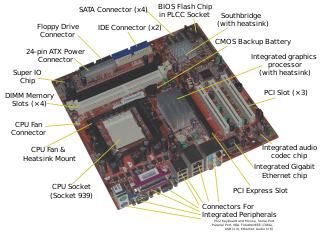Dynamic drive overlay (DDO, also referred to as: software translation driver) is a software technique to extend a system BIOS that does not support logical block addressing (LBA) to access drives larger than 504 MiB. The technology was continued with similar types of problems up to the LBA-48 extension.

BIOS is non-volatile firmware used to perform hardware initialization during the booting process, and to provide runtime services for operating systems and programs. The BIOS firmware comes pre-installed on a personal computer's system board, and it is the first software to run when powered on. The name originates from the Basic Input/Output System used in the CP/M operating system in 1975. The BIOS originally proprietary to the IBM PC has been reverse engineered by companies looking to create compatible systems. The interface of that original system serves as a de facto standard.
Logical block addressing (LBA) is a common scheme used for specifying the location of blocks of data stored on computer storage devices, generally secondary storage systems such as hard disk drives. LBA is a particularly simple linear addressing scheme; blocks are located by an integer index, with the first block being LBA 0, the second LBA 1, and so on.
This technique overrides some of the motherboard BIOS' hard disk controller driver in RAM. To allow access to the full size of any hard disk the software must be loaded before other programs try to access the upper parts of a disk with a critical size. To ensure that this extension gets loaded early most often the boot disk's master boot record is modified and the software installed at the beginning of the disk.

A motherboard is the main printed circuit board (PCB) found in general purpose computers and other expandable systems. It holds and allows communication between many of the crucial electronic components of a system, such as the central processing unit (CPU) and memory, and provides connectors for other peripherals. Unlike a backplane, a motherboard usually contains significant sub-systems such as the central processor, the chipset's input/output and memory controllers, interface connectors, and other components integrated for general purpose use and applications.
A boot disk is a removable digital data storage medium from which a computer can load and run (boot) an operating system or utility program. The computer must have a built-in program which will load and execute a program from a boot disk meeting certain standards.
The most widespread vendor for such an extension is the company Ontrack which is licensing its DDO component to several of the major hard disk vendors for integration into their management tools and into their products.

Kroll is a corporate investigations and risk consulting firm based in Midtown Manhattan, New York City. It was established in 1972.
The application of a Dynamic Drive Overlay (DDO), as licensed to Samsung Corporation for example, by Kroll Ontrack's version in their Disk Manager program is for the installation of various hard drives (Ultra/Super IDE/Parallel ATA) in computers that have older BIOS chips that do not recognize hard disk drives larger than 137.4 Gigabytes. [1] The interface is a software program that is loaded at start-up by the computer and augments the BIOS code, thus allowing the system to recognize and read areas of the hard disk drive that normally would not be accessible by the older BIOS.

Parallel ATA (PATA), originally AT Attachment, is an interface standard for the connection of storage devices such as hard disk drives, floppy disk drives, and optical disc drives in computers. The standard is maintained by the X3/INCITS committee. It uses the underlying AT Attachment (ATA) and AT Attachment Packet Interface (ATAPI) standards.
The gigabyte is a multiple of the unit byte for digital information. The prefix giga means 109 in the International System of Units (SI). Therefore, one gigabyte is 1000000000bytes. The unit symbol for the gigabyte is GB.



